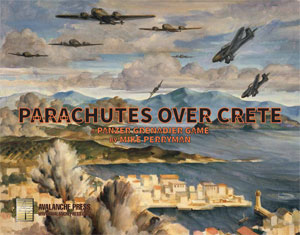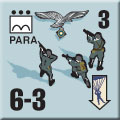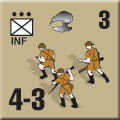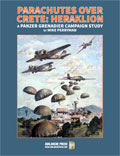Parachutes over Crete:
Scenario Preview, Part Six
by Mike Bennighof, Ph.D.
September 2024
 I first became aware of the Battle for Crete when I was in the fourth grade. A Greek child in my class named Sam learned of my origins and proclaimed that Greeks had fought Austrians with pitchforks during the war, during a battle for someplace called Crete. Then he shoved me, I punched him repeatedly in the face, and I had to spend a whole day in the principal’s office. I want to be clear on that: as I told the principal, he started it. I first became aware of the Battle for Crete when I was in the fourth grade. A Greek child in my class named Sam learned of my origins and proclaimed that Greeks had fought Austrians with pitchforks during the war, during a battle for someplace called Crete. Then he shoved me, I punched him repeatedly in the face, and I had to spend a whole day in the principal’s office. I want to be clear on that: as I told the principal, he started it.
Much later I learned that there wasn’t one battle for Crete, but four of them taking place at the same time. That makes it a perfect subject for a Panzer Grenadier game, so that’s what we’ve done with Parachutes Over Crete. Let’s wrap up our scenario preview by looking at those from the smallest of the battles covered, that for Rethymnon.
Scenario Thirty
East of the Airfield
20 May 1941
 German intelligence vastly underestimated the number of Allied troops on Crete and were particularly low on the number stationed around Rethymnon. Thinking the area was lightly defended only two battalions dropped there and part of this force was detailed to advance on Suda Bay. Unfortunately for the Germans two battalions of Australian infantry were waiting for them on two hills that overlooked the airfield with two Matilda tanks. Two battalions of Greeks plus Australian artillery, engineers and machine-gunners stood ready nearby. German intelligence vastly underestimated the number of Allied troops on Crete and were particularly low on the number stationed around Rethymnon. Thinking the area was lightly defended only two battalions dropped there and part of this force was detailed to advance on Suda Bay. Unfortunately for the Germans two battalions of Australian infantry were waiting for them on two hills that overlooked the airfield with two Matilda tanks. Two battalions of Greeks plus Australian artillery, engineers and machine-gunners stood ready nearby.
Conclusion
A poorly-coordinated airlift brought the German groups to their landing zones at different times, with a large part of the force dropping too far to the east of be of immediate help. The remaining two companies landed on the eastern end of the airfield and immediately came under heavy fire. The battalion commander, Major Hans Kroh, quickly led the two companies that landed with him to the airfield, with two more joining him along the way. The Australians on Hill A would have to be overcome before the German could reach the airfield. Kroh led his paratroopers up the hill, and after hard fighting they forced the Australians to fall back. A counter-attack led by the two Matilda tanks restored the situation. When darkness fell the Australians held the west side of the hill with the Germans on the east side of the hill and the crest empty.
Notes
A parachute landing scenario, with some of the Germans so badly scattered that they come onto the board later in the game. The landing zones are right on top of the Australian and Greek defenders, so much will depend on how many Germans survive that initial encounter.
Scenario Thirty-One
Ready and Waiting
20 May 1941
While Rethymnon had a much smaller garrison than the other targeted airfields, due to the field’s smaller size and capacity, the German landings came an hour after those at Maleme. Lt. Col. Ian Campbell of 2/1 Australian Infantry Battalion, responsible for the nearby Greek units as well, had been fully informed and alerted his troops to expect an airborne attack. Soon enough, they spotted silk parachutes drifting down on top of them.
Conclusion
The German landings came down almost on top of the defenders, who proved far more numerous than intelligence briefings had predicted. Their regimental commander, Col. Alfred Sturm, was captured along with most of his headquarters staff, and the Australians claimed to have counted over 400 German dead the next day.
Notes
Another contested parachute landing, and this time the Germans are dropping heavy weapons along with paratroopers. Once again, the landings will determine the outcome; if the Germans can survive those pitchfork-wielding Greeks, they have a good chance of taking the airfield.
Scenario Thirty-Two
Second Parachute Regiment
20 May 1941
Maj. Gen. Kurt Student included Rethymnon as an objective in order to spread and confuse the Allied defense; the airstrip at the nearby village of Pigi had been built by the Royal Air Force to handle light aircraft and had no support facilities. Aerial reconnaissance missed most of the defenders, and even worse for the attackers, the Australians were aware that the Germans had missed most of the defenders - a German plane bearing an intelligence report that included photos had been shot down.
Conclusion
The Rethymnon landings would be a disaster for the Germans, relieved only by the poor supply situation of the Australians which kept them from finishing off the surviving airborne troops. Campbell asked for reinforcements to help counter-attack the Germans, but Freyberg at Creforce headquarters told him there were none to send. The Rethymnon garrison was on its own.
Notes
This is one of those combined-scenario scenarios, melding together the previous two into one big parachute landing. That doesn’t make it any easier for the Germans.
Scenario Thirty-Three
Police Academy
20 May 1941
 The German force tasked with taking Rethymnon’s airfield, already smaller than the other task forces, was further divided into three groups for the landings. That assigned to land inland of the coastal village of Perivolia (not the same town as that in the Canea region) arrived hours late, when the defenders had already been alerted. No Australian troops had been posted here, but the local Greek Gendarmerie (the militarized national police) and armed Cretan civilians stood more than ready to offer battle. The German force tasked with taking Rethymnon’s airfield, already smaller than the other task forces, was further divided into three groups for the landings. That assigned to land inland of the coastal village of Perivolia (not the same town as that in the Canea region) arrived hours late, when the defenders had already been alerted. No Australian troops had been posted here, but the local Greek Gendarmerie (the militarized national police) and armed Cretan civilians stood more than ready to offer battle.
Conclusion
Almost all of the Gendarmes had been cadets at Crete’s Gendarmerie Academy before the war, and had been enraged when they were not allowed to travel to the mainland to fight the hated Italian invaders. They had been formed into a battalion shortly before the German airborne invasion, and in their first action they turned back the German paratroopers who retreated to Perivolia.
Notes
Greek morale is at its highest, and they have numbers too as they face off with the German paratroopers, who have to somehow get past the battle-hungry rookie cops without losing too many of their own.
Scenario Thirty-Four
Aussie Initiative
21 May 1941
While the New Zealanders at Maleme dithered and allowed the Germans to consolidate their positions and capture the airfield, the Australians around Rethymnon acted immediately to crush the airborne landings. The first day’s fight left Hill A, as the Australians had labelled the easternmost height in their defense zone, disputed between the Australians and Germans. Lt. Col. Ian Campbell, the sector commander, was determined to drive the enemy off with a dawn attack, just as Major Hans Kroh of the German battalion was determined to push past the hill and take the landing strip.
Conclusion
The Australians struck first, but the Germans held firm and within minutes had inflicted heavy casualties on the attackers. An hour later the Germans launched their own attack and had much more success, threatening to take Hill A. Campbell personally led his reserve company in a counter-attack that drove the Germans completely off the hill, greatly easing the threat to the airstrip.
Notes
Everyone sets up within spitting distance of each other, and then the brawling begins. There’s attack and counter-attack and counter-counter-attack in a frenzy to control the airfield and te hill that dominates it.
Scenario Thirty-Five
Pressed Olives
22 May 1941
On top of the loss of paratroopers killed and wounded, a number of unwounded men surrendered to the Australians - just how many is unclear, as they would be liberated a few days later and included medical personnel ordered to remain behind. Kroh led the remainder about a mile to the east where they fortified an olive oil pressing factory and detached more men to cover a supply drop zone several miles to the east. The Australians and their Greek allies gave Kroh no breathing space.
Conclusion
In yet another incidence of poor Allied communications on Crete, only the Australians went forward in this attack. Even so they outnumbered the Germans, but could not match the firepower of the German machine guns and the machine pistols wielded initially by every fourth paratrooper (and many more men had probably picked them up from dead or wounded comrades). Over the next few days the Australians manhandled their “bush artillery” (two 75mm howitzers captured from the Italians in Libya) to point-blank range and destroyed the olive oil factory.
Notes
The Germans are clinging to their fortress of solitude, and it’s up to the Australians to root them out. It’s just a small scenario, but a pretty intense one.
Scenario Thirty-Six
Strongpoint Perivolia
28 May 1941
The Australians fighting around Rethymnon had been out of contact with anyone outside of their sector since the fighting started. On the 21st they had driven the surviving paratroopers into Stavromenos and Perivolia. Since then they had been trying to overcome these strongpoints but superior German firepower had continually balked them. A day after Creforce decided to evacuate Crete, the Australians again went forward.
Conclusion
Despite strict instructions not to do so, the Greeks opened fire minutes after the Australians started to move forward, alerting the Germans to their presence. By 0430 the lead company had withdrawn with heavy loses. The support company decided that the green flare which was the signal to retire was a German flare and pressed forward. They occupied some houses on the outskirts of the town and held them throughout the day. When no reinforcements arrived, they retired to their original positions.
Notes
We wrap up the chapter with another small scenario, and Australian assault on a company-sized cluster of resolute German holdouts. The Greek help isn’t much this time, but the Australians have the numbers to get the job done, except for the firepower of all those German machine guns.
And that wraps up our scenario preview of Parachutes Over Crete.
You can order Parachutes Over Crete right here.
Add More Fun!
 Parachutes Over Crete: Heraklion Parachutes Over Crete: Heraklion
A set of nine scenarios, plus historical background and three battle games, drawn from the May 1941 German airborne assault on Herkalion, capital of Crete, defended by the British 14th Brigade and determined Greeks. Requires Parachutes Over Crete and Road to Dunkirk.
You can order Heraklion right here.
Parachutes Package
Parachutes Over Crete
Road to Dunkirk
Heraklion
Retail Price: $192.97
Package Price: $155
Gold Club Price: $124
You can experience the Parachutes Package right here.
Sign up for our newsletter right here. Your info will never be sold or transferred; we'll just use it to update you on new games and new offers.
Mike Bennighof is president of Avalanche Press and holds a doctorate in history from Emory University. A Fulbright Scholar and NASA Journalist in Space finalist, he has published a great many books, games and articles on historical subjects; people are saying that some of them are actually good.
He lives in Birmingham, Alabama with his wife and three children. He misses his Iron Dog, Leopold. Leopold was not parachute-deployable.
Daily Content includes no AI-generated content or third-party ads. We work hard to keep it that way, and that’s a lot of work. You can help us keep things that way with your gift through this link right here.
|
